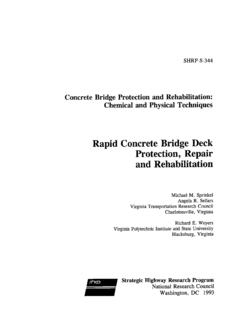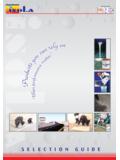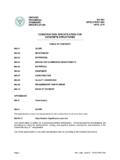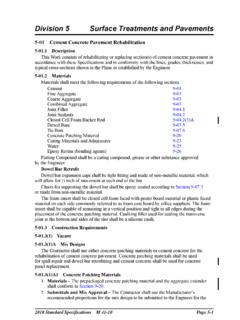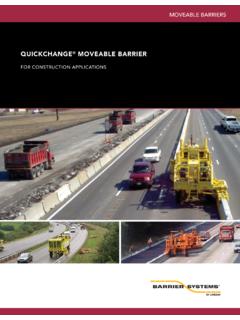Transcription of BRIDGE DECK & ROADWAY REHABILITATION SYSTEMS
1 923 Teal DriveBenicia, California 94510(866) 434-1772(707) 746-7981 deck & ROADWAY REHABILITATION SYSTEMS k w i k b o n d p o l y m e r s . c o m1 PRODUCT DESCRIPTIONPPCTM 1121 EC is a polyester-based polymer overlay and patching system designed for the rapid repair and REHABILITATION of PCC BRIDGE decks and pavements. PPCTM 1121 EC achieves over 4000 psi in compressive strength within 24 hours as well as over 850 psi in tensile strength. Adhesion testing, in accordance with ACI 503, results in failure to PCC concrete 1121 EC offers some important features PPCTM 1121 EC has very high strength mechanical properties PPCTM 1121 EC has a low modulus of elasticity with correspondingly less strain to the bond line resulting in superior adhesion PPCTM 1121 EC, when mixed and applied properly, withstands traffic loads within hours at temperatures down to 40 F.
2 PPCTM 1121 EC can be placed at thicknesses from 3/4 to 12 in a single lift PPCTM 1121 EC seals PCC surfaces and is a barrier to chlorides and other environmental contaminants PPCTM 1121 EC technology has been in continuous use for over 25 yearsFor today s congested bridges and highways, PPCTM 1121 EC is the right material for high density polymer concrete overlays. This product is extremely useful for protective overlays, patching, and pairing Portland cement concrete, latex modified concrete, or silica fume modified FEATURES Low viscosity for easy mixing Rapid curing and strength development Superior adhesion to Portland cement concrete, latex modified concrete, silica fume concrete even under damp conditions Excellent compressive and tensile properties Low compressive modulus resulting in a tough paving materialPRODUCT DATA SHEET: PPCTM 1121 EC2 k w i k b o n d p o l y m e r s.
3 C o mKWIK BOND POLYMERS, LLCPHYSICAL PROPERTIES PPC Binder ResinWeight per gallon(resin binder only) <200cpsFlash Point(Setaflash)90 FAdhesion(Saturated Surface Dry Bond Test)>500 psiTensile Strength (ASTM D-638, specimen)>2500 psiTensile Elongation (ASTM D-638, specimen)35%, minMeets CARB(California Air Resources Board Regulations for Emissions)Rule 1162 Styrene content45-55%PHSYCIAL PROPERTIES PPC -1121 ECTensile Strength(ASTM C-307)800 psi typicalCured Density(ASTM C905)135 lbs/cu ft (avg)Compressive Strength(ASTM C-39)7000 psiAggregates for the 1121 system have a minimum Moh hardness of The aggregates have a low absorption and are kiln dried.
4 The important characteristic of 1121 aggregate system is its workability and ease of compaction. APPLICATIONS urface Preparation: Shot-blasting is the preferred method of preparation for BRIDGE deck overlays. The goal of surface preparation is to remove all deleterious dirt, asphalt and curing compounds from the deck surface as well as expose aggregate. Sandblasting, roto-milling, chipping, or other preparation processes may be used as alternative preparation methods to provide proper surface preparation for a long-lasting polymer overlay and/or patching system .
5 Unsound concrete areas should be located by using a chain-drag or hammer. The unsound areas must be removed until a sound concrete base is : After the BRIDGE deck area to be overlayed is cleaned and prepared properly, follow the next steps to remove unsound concrete: 1. Saw cut(dry blade) a minimum depth shoulder around the edge of the prepared spall area 2. Chip out and remove delaminated surfaces 3. Blow off(sweep away) dust from saw cutting and chipping operations 4. Prime the spall with KBP 204, high molecular weight methacrylate primer 5. Mix PPCTM 1121 EC according to the mix design outlined below 6.
6 Fill the prepared area to rough grade; screed to final grade 7. Texture finished surface with 10 x 30 sandblast sand and/or tine 8. Overlay operations are similar except screeds are set to achieve specified depth and grade profilePPCTM 1121 EC system Primer: Mix 1 gallon KBP 204 with 3 fluid ounces of 6% Cobalt Drier(Dark Blue Material). Stir for 10 seconds. Add 3 fluid ounces of Cumene Hydro Peroxide and stir for another 30 seconds (Note: use a mechanical agitator to stir the components). Using a paint brush or similar applicator, PRODUCT DATA SHEET: PPCTM 1121 EC3 k w i k b o n d p o l y m e r s.
7 C o mKWIK BOND POLYMERS, LLCwet-out the entire surface of the area to be repaired. KBP 204 is very fluid and will wet the surface quickly. The excess will rapidly build-up at the lowest points in the prepared area. Minimize excess primer in the deep valleys of areas to be overlaid or patched. Some build-up is unavoidable. Note: This mix ratios listed above represents a starting point for anticipated temperatures of 70 F during daytime installation conditions. Modifications may be required for working under different temperature conditions or during night time application.
8 For very warm day time temperatures, night time application should be considered. Reducing CHP levels to 1 fl oz per gallon during elevated temperatures should be evaluated. During cold night time application, both Promoter and CHP levels may be increased. Adding Kwik Bond s Z Cure accelerator may be required. Mix Design: To a standard mortar mixer, add 4 gallons of PPCTM Binder Resin. Begin agitation. Add 7-12 of DDM 9 initiator (MEKP) , depending on temperature and conditions to achieve a minimum set time of 20-40 minutes. While agitating, add 100 lbs.
9 Of KBEC 39 Coarse Aggregate. Continue Agitation. Add 200 lbs.(4 bags) of KBEC 11 Fine Sand. Mix for an additional one to two minutes and dump into a transfer device. Follow the finishing steps described below. Approximate yield from the mix is cubic feet. Read the notes section regarding primer mix design and application. Mix design modifications are required for changes in temperature or night time application. Higher or lower catalyst additions may be required as well as substitution of faster catalysts for night time conditions.
10 Temperature and application timing have a definite effect upon set time of the polyester polymer concrete and the ultimate return to service. For high volume applications, a positive displacement, plural component pump with appropriate monitoring equipment may be added to a volumetric mixer to obtain outputs of upward of 8-10 cubic yards every 30 minutes. Finishing: Deliver mixed material to work area. For repair of PCC spalls, fill areas to rough grade with the PPC 1121 EC mix. Strike-off to final grade. Lightly tamp to drive out residual air and trowel smooth.


